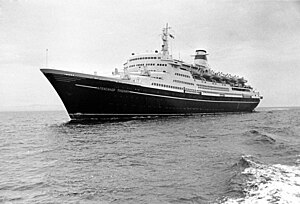 Aleksandr Pushkin, 1966
| |
| Class overview | |
|---|---|
| Builders | VEB Mathias-Thesen Werft, Wismar, East Germany |
| Preceded by | Mikhail Kalinin class (project 101/SeeFa 340) |
| Built | 1963–1972[1] |
| In service | 1964–2020 |
| Planned | 5 |
| Building | 5 |
| Completed | 5 |
| Active | 0 |
| Lost | 1 |
| Retired | 4 |
| General characteristics | |
| Type | Ocean liner → Cruise ship |
| Tonnage | 19,861 GRT[2] |
| Length | 175.79 m (577 ft) overall[2] |
| Beam | 23.61 m (77 ft)[2] |
| Height | 16.19 m (53 ft)[2] |
| Draught | 8.11 m (27 ft)[2] |
| Decks | 8 passenger decks |
| Installed power | 2 × Sulzer-Cegielski 7RND76 diesels, 15,666 kW (21,008 hp)[1] |
| Propulsion | 2 propellers |
| Speed | 20.45 knots (37.87 km/h; 23.53 mph)[2] |
| Capacity | 750 passengers |
The Ivan Franko-class passenger ship (project 301, in Germany known as Seefa 750[3]) was a class of Soviet ocean liners and cruise ships, operated by the Baltic State Shipping Company (BGMP) and Black Sea Shipping Company (ChMMP or BLASCO).[4] The five Soviet ships Ivan Franko, Aleksandr Pushkin, Taras Shevchenko, Shota Rustaveli and Mikhail Lermontov were constructed in 1963–1972 by the East German company VEB Mathias-Thesen Werft, in Wismar. The class was named after its lead ship, which took its name from the Ukrainian poet Ivan Franko. The last remaining vessel, the Aleksandr Pushkin – last known as Marco Polo, was retired in 2020 and beached in Alang, India for scrapping on 13 January 2021.[5]
- ^ a b M/S Aleksandr Pushkin(in Swedish)
- ^ a b c d e f Регистровая книга морских судов СССР 1964–1965 [Register Book of Sea-going Ships of the USSR] (in Russian). Archived from the original on 2013-11-03. Retrieved 11 January 2019.
- ^ "DDR Schiffbau". german-shipbuilding.com (in German). Archived from the original on 2013-06-15. Retrieved 11 January 2019.
- ^ "Ivan Franko Class". simplonpc.co.uk. Retrieved 11 January 2019.
- ^ Gonzalez, Frank. "[VIDEO] CMV Marco Polo Beaching in Alang Scrap Yard". Cruises-Info.com. Retrieved 14 January 2021.